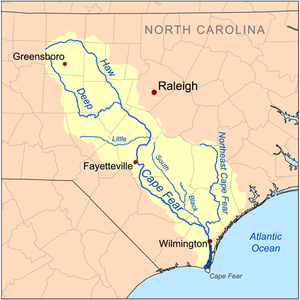Battle of Cape Fear River
| Battle of Cape Fear River | |||||||
|---|---|---|---|---|---|---|---|
| Part of the Golden Age of Piracy | |||||||
 A map of the Cape Fear River. |
|||||||
|
|||||||
| Belligerents | |||||||
|
|
|
||||||
| Commanders and leaders | |||||||
|
|
|
||||||
| Strength | |||||||
| 2 sloops-of-war | 3 sloops-of-war 3 canoes |
||||||
| Casualties and losses | |||||||
| 12 killed 18 wounded 2 sloops-of-war damaged |
12 killed or wounded ~40 captured 3 sloops-of-war captured 3 canoes captured |
||||||
The Battle of Cape Fear River, or the Battle of the Sandbars, was fought in September 1718 between a British naval from South Carolina against the pirate ships of Stede Bonnet. British forces defeated the pirates in the Cape Fear River estuary which led to Bonnet's death by hanging in Charleston.
During the end of the Golden Age of Piracy, the Royal Navy was constantly in campaign against pirates in the Caribbean and off North America. Stede Bonnet was a very successful pirate, having captured several merchant ships and assembled his own squadron of pirate ships. In August 1718, Bonnet was sailing from the Delaware Bay to the Cape Fear River. He commanded his sloop-of-war flagship Royal James and two other armed sloops, Francis and Fortune. Royal James was a former flagship of Blackbeard which was armed with eight cannon. The other two sloops were similarly armed. All together, 46 pirates crewed them. Royal James was in need of careening and the hurricane season was soon to come so Bonnet chose the Cape Fear estuary as a reliable shelter against storms. For the next few weeks, Bonnet's crew repaired the Royal James with material salvaged from a captured shallop.
In late August, reports of Bonnet's sloops in the Cape Fear River reached Governor Robert Johnson of South Carolina. Johnson ordered Militia Colonel William Rhett to command an operation to destroy the pirate threat. He did not have regular Royal Navy Sailors under his command, but probably volunteer militiamen and sailors from Charleston. At the colonel's disposal were two eight-gun sloops with a combined 130 men.
...
Wikipedia
